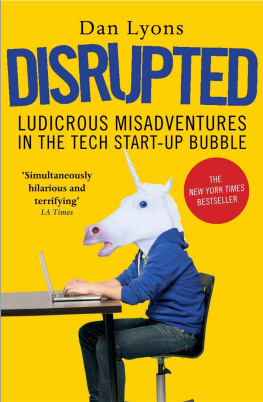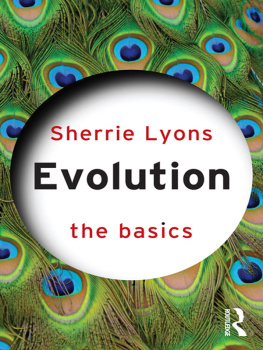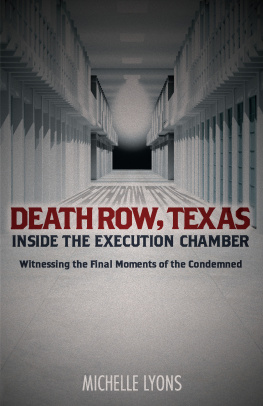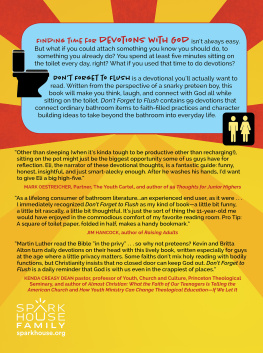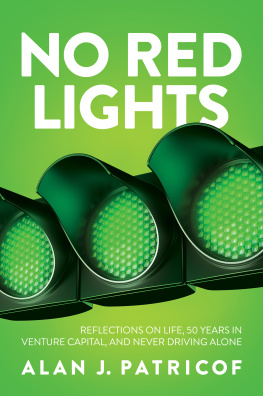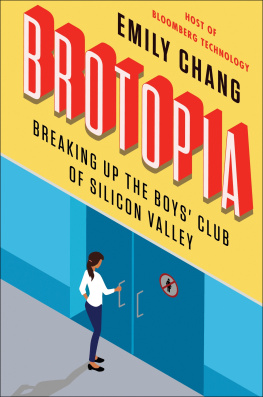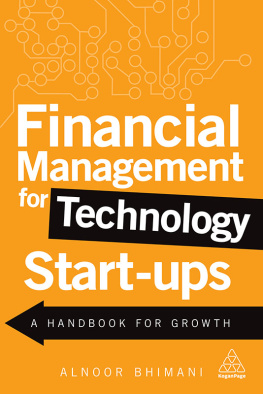
FOR TEAM SHRED: L.S., M.B. & P.B.
THE BEST PALS EVER
Authors Note
Ive spent the past decade writing satire about the technology industryfirst on a blog, then in a novel, and most recently on a TV show. But nothing I ever dreamed up in those fictional accounts could compare to the ridiculousness I encountered when I took a job at an actual tech company, a software maker called HubSpot. This book is the chronicle of my time at the company, and its not satire. Everything in Disrupted really happened. With some individuals I have used real names, but in most cases I have invented pseudonyms and nicknames. Some current and former HubSpotters agreed to be interviewed for the book, but only on condition that our conversations remain off the record. Some people were afraid to talk to me at all. At the time I thought their concerns were silly. But as things turned out, those people may have been right to be afraid.
Regarding terminology: When I use the term Silicon Valley I do not mean to denote an actual geographic regionthe sixty-mile peninsula between San Francisco and San Jose, where the original technology companies were built. Instead, like Hollywood, or Wall Street, Silicon Valley has become a metaphorical name for an industry, one that exists in Los Angeles, Seattle, London, New York, Boston, and countless other places, as well as the San Francisco Bay Area.
The term bubble, as I use it, refers not only to the economic bubble in which the valuation of some tech start-ups went crazy but also to the mindset of the people working inside technology companies, the true believers, the people who live inside their ownfilter bubble, brimming with self-confidence and self-regard, impervious to criticism, immunized against reality, unaware of how ridiculous they appear to the outside world.
HubSpot, where I worked from April 2013 to December 2014, was part of that bubble. In October 2014, the company floated a successful IPO, and it now has a market value of nearly $2 billion. But this book is about more than HubSpot. This is a story about what its like to try to reinvent yourself and start a new career in your fifties, particularly in an industry that is by and large hostile to older workers. Its a story about how work itself has changed, and how some companies that claim to be making the world a better place are in fact doing the opposite.
Myths and mythmaking are rampant in Silicon Valley. I wrote this book because I wanted to provide a more realistic look at life inside a unicorn start-up and to puncture the popular mythology about heroic entrepreneurs. HubSpots leaders were not heroes, but rather a pack of sales and marketing charlatans who spun a good story about magical transformational technology and got rich by selling shares in a company that still has never turned a profit.
At the heart of the book is my own sometimes painful and humbling journey of self-discovery, as I attempted to transform myself from a journalist into a marketing professional at a software start-up. My hope is that my story offers an overdue behind-the-scenes look at life inside a start-up during a period when the tech industry had temporarily lost its mindand when I, for better or worse, did the same.
Contents
Midway on our lifes journey, I found myself
In dark woods, the right road lost.
Dante Alighieri
I used to be with it. But then they changed what it was.
Now what Im with isnt it, and whats it seems weird and scary to me.
Grampa Simpson
Prologue
Welcome to the Content Factory
I f you made a movie about a laid-off, sad-sack, fifty-something guy who is given one big chance to start his career over, the opening scene might begin like this: a Monday morning in April, sunny and cool, with a brisk wind blowing off the Charles River in Cambridge, Massachusetts. The mangray hair, unstylishly cut; horn-rimmed glasses; button-down shirtpulls his Subaru Outback into a parking garage and, palms a little sweaty, grabs his sensible laptop backpack, and heads to the front door of a gleaming, renovated historic redbrick building. It is April 15, 2013, and that man is me. Im heading for my first day of work at HubSpot, the first job Ive ever had that wasnt in a newsroom.
HubSpots offices occupy several floors of a nineteenth-century furniture factory that has been transformed into the clich of what the home of a tech start-up should look like: exposed beams, frosted glass, a big atrium, modern art hanging in the lobby. Riding the elevator to the third floor, I feel both nerves and adrenaline. Part of me still cant believe that Ive pulled this off. Nine months ago I was unceremoniously dumped from my job at Newsweek magazine in New York. I was terrified that I might never work again. Now Im about to become amarketing guy at one of the hottest tech start-ups on the East Coast. There is one slight problem: I know nothing about marketing. This didnt seem like such a big deal when I was going through the interviews and talking these people into hiring me. Now Im not so sure.
I reassure myself by remembering that HubSpot seems pretty excited about having me come aboard. Cranium, the chief marketing officer or CMO, wrote an article on the HubSpot blog announcing that he had hired me. Tech blogs wrote up the story of the fifty-two-year-old Newsweek journalist leaving the media business to go work for a software company.
But when I arrive at HubSpots reception desk, something weird happens: Nobody is expecting me. The receptionist, Penny, who could pass for a high school student, has no idea who I am or why Im here. She frowns and looks me up on her computer: nothing. This seems odd. I wasnt expecting a brass band and balloons, but I did assume that someone, presumably my boss, would be there to meet me on my first day at work.
Im going to be working for Cranium, I tell Penny.
Cranium is a big, hulking, baby-faced guy in his late thirties who once was a college football lineman and still looks the part. In his official HubSpot management team photo, he wears an open-collar oxford shirt and a white T-shirt, like a beefy-faced frat boy. Officially he is the person who hired me, but the decision was made by HubSpots co-foundersBrian Halligan, the CEO, and Dharmesh Shah, the chief technology officer. Halligan and Shah didnt recruit me; I recruited them. I found HubSpot through a job posting on LinkedIn, had two interviews, and finally met with Halligan and Shah, who offered me a job as a marketing fellow. The title was unusual, but also pleasing, with a quasi-academic ring to it and an implication that my role would be to serve as a kind of minence grise at the company. My job description was vague, but I believed I would be writing articles for the HubSpot blog, advising executives on media strategy, writing speeches for the CEO, and attending conferences as a kind of brand evangelist.
Penny makes some calls. Finally she tells me that Cranium is not in theoffice today. I check the calendar on my phone and glance through my email to make sure Ive arrived on the correct day. As far as I can tell, I have.
How about Wingman? I say. Wingman is Craniums sidekick, a thirty-one-year-old director of something or other. Ive met Wingman, and hes nice enough. I dont really know what he does, but basically he seems to be a mini-Cranium. Wingman actually looks like Craniumround-faced, with short hairand dresses like him, wearing a business casual uniform of jeans, sport coat, open-collar oxford shirt and white T-shirt.

